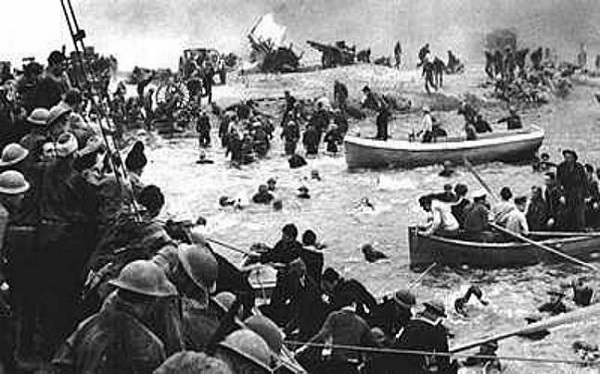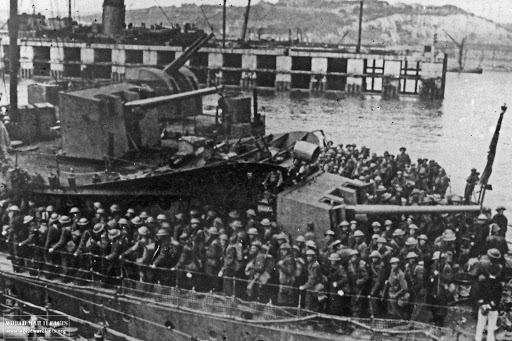Dunkirk : Biggest Evacuation Of World War II
Total Views |
Wars are not won by evacuations. It does not represent a victory” These were the chilling words of Prime Minister Mr Winston Churchill in June,1940 while over 300,000 soldiers of the British Expeditionary Force had lined up on the beach of Dunkirk for the biggest beach evacuation in World War II. Dunkirk Evacuation, although successful in the face of daunting odds, was the lowest moment for the British in both the World Wars. It was a success, but not a victory.
The English Channel is an extension of the Atlantic Ocean that separates Southern England from Northern France and links to the Southern part of the North Sea by the Strait of Dover at its Northeastern end. It is the busiest shipping area in the world. It is about 560 km long and varies in width from 240 km at its widest to 34 km in the Strait of Dover. It is a Shallow Seas around the continental shelf of Europe, covering an area of some 75,000 Square km. It has Strategic Importance as a tool for blockade of English Channel which is a barrier-moat for England against foreign attacks.

Germany invaded Poland in September 1939 but didn’t inflame the war to the extent of pushing then Prime Minister Neville Chamberlain into attacking it. Britain declared war on Germany in after it invaded Poland, but took NO action following that declaration. Britain sent soldiers to France to sure up defences in the event of an invasion and also to deter Hitler from invading it. Soldiers sent to France to deter German invasion formed part of the British Expeditionary Force (BEF). Chamberlain had wrongly believed Hitler wouldn’t aggravate the war further by invading any more countries in Europe. But all that changed on 10 May, 1940, when Hitler ordered the simultaneous invasion of Belgium, Netherlands, Luxembourg and France. The invasion of all of these countries is generally referred to as 'The Battle of France' because other three countries were technically neutral until Hitler's forces invaded them, whereas France had stood with Britain against Germany since September 1939. Neville Chamberlain resigned as the Prime Minster. His resignation paved the way for a different style of War Time Leadership and the man chosen to provide that was Winston Churchill.
When the Panzer Tanks of the German Army began their “Blitzkrieg” over the boarders into Belgium, Netherlands and France, aided by air cover from the Luftwaffe; BEF found themselves pushed further and further back towards the English Channel day by day. Ferocity of this new style of warfare, Blitzkrieg, could not matched by Forces of Belgium, France and Britain. By 21 May, 1940, BEF found itself cut off, isolated and surrounded by German forces on the Northwest beaches of France. Situation was dire enough for General Viscount Gort, British Commander in France, to concede the battle lost, and so he requested to have his Forces evacuated out of France as earnestly as possible. Gort identified Dunkirk, a coastal town to North of Calais to handle this evacuation, Evacuation of the standard British, French and Belgian soldiers at Dunkirk was code named “Operation Dynamo”. The plan was to use Naval assets and all civilian vessels situated in the South of England to get across the English Channel and pick up the stranded Allied Soldiers. Operation Dynamo began on 26 May and continued until the last men got off the beach at Dunkirk on 04 June,1940.
To aid the evacuation, the Ministry of Shipping requisitioned approximately 800 “Little Boats” from areas across the South of England, including the River Thames Boat Owners didnot know their crafts had been commandeered for the operation. Navy tried to place Military Personnel on each of the crafts, but when the call came to sail across the Channel and begin the rescue, hundreds set off crewed solely by civilians. The flotilla of civilian crafts included Speedboats, Car ferries, Motor lifeboats and Pleasure crafts. Little boats picked up 98,671 men standard Soldiers on beach, freeing up the larger ships to collect men off the Mole. While the little boats crewed largely by civilians picked up stranded men on the beach, larger ships picked up the bulk of the BEF via the Mole at Dunkirk Harbour. The Royal Navy provided over 40 ships including HMS Calcutta, an Anti Aircraft Cruiser, 39 Destroyers and other crafts including Minesweepers, Gunboats, Torpedo boats and Hospital Carriers. The Merchant Navy also played a vital role in the operation.
While the soldiers waited to be evacuated either from the Mole, a long man made concrete arm that ran out to sea from the Harbour for about a mile, or from the beach itself, the Luftwaffe subjected the hundreds of thousands of waiting Allied Troops to aerial bombardment in the waters around Dunkirk, German U Boats attacked rescuing Vessels as they arrived and departed. In the skies above Dunkirk, the Royal Air Force engaged in an almost constant Air Battle with the Luftwaffe to help protect the men waiting on the beaches below. In first three days of evacuation, there were such substantial losses of Naval Vessels from the bombing attacks by the Luftwaffe and Nazi U Boats that, Admiralty withdrew several Destroyers from the operation for the future defence of the Britain.

At the end of Operation Dynamo, the larger ships had rescued 239,555 men from Dunkirk Harbour, mostly by mooring alongside the Mole. Ships also collected men from other crafts damaged by explosions, or by the transferring of men from the little boats. During Dunkirk Evacuation, Luftwaffe dropped 30,000 Incendiary and 15,000 High Explosive Bombs on the trapped men standing/waiting on Mole and beaches below. BEF abandoned almost all its Heavy Equipment as it retreated towards the coast in France to include, 85,000 vehicles, Half Million Tonnes of Stores, 76,000 Tonnes of Ammunition and almost all Tanks. Nine Destroyers including six British were los and 200 Civil Vessels now sit on the seabed of the English Channel. RAF was engaged in the fiercest Dog Fight (Air to Air Fight) which later became Folk Lore of the Yore. RAF sustained the loss of 145 aircraft, 42 of which were Spitfires. One of those Spit Fire has been renovated and remodeled flew just a couple of days back in May,2020.Preceding weeks of the Dunkirk Evacuation and Operation Dynamo itself saw the loss of 68,000 men including 6800 Indian Troops. . It was a terrible outcome for the British. The evidence of war remains vivid at Dunkirk even today. Britton will be offering their Tribute to these Men this Week.
The Dunkirk Evacuation is also known as “Miracle of Dunkirk” for Two reasons; One; weather conditions over the English Channel allowed 800-strong Civilian Flotilla to cross the often challenging waters of the Channel unimpeded. In bad weather and reverse current, those crafts could not have reached beaches of Dunkirk. This would have resulted in men on beaches being exposed to German Forces coming at them from all sides for longer duration. Two; for reasons best known to him only, Hitler ordered his Ground Forces to stop attacking Dunkirk for three days at the start of the evacuation. He ordered Luftwaffe to finish off the job of destroying the BEF without taking in to account, Skill and Tenacity of the RAF, who put up a better fight than their German counterparts. In doing so, Hitler gave crucial time to BEF to sure up defences on the Flanks of Dunkirk, which held out long enough for 338,226 men to be rescued. This was a costly decision by Hitler which is labeled as “One his biggest mistakes of the war”. The flanks of Dunkirk were protected, thinly, by French soldiers who surrendered to Germans and became Prisoners of War at the end of evacuation. Without their holding of the flanks, evacuation would not have been a success. Battle of France continued for some weeks into June, 1940 and ended in victory for Germany. It would be the high point of the war for Hitler, but for Britain it marked the start of what was referred to by Winston Churchill as “Our Darkest Hour.”
On June 4, 1940, Prime Minister Winston Churchill made his most Famous Speech of the War. In his address at the House of Commons, in response to calling on him to offer terms to Hitler under a Negotiated Peace, Churchill said: “We shall go on to the end. We shall fight in France, we shall fight on the seas and oceans, we shall fight with growing confidence and growing strength in the air, we shall defend our island, whatever the cost may be. We shall fight on the beaches, we shall fight on the landing grounds, we shall fight in the fields and in the streets, we shall fight in the hills but we shall never surrender”.
German occupation of Channel Islands during1940–1945 was harsh, with some island residents being taken for slave labour on the Continent; native Jews sent to concentration camps; partisan resistance and retribution; accusations of collaboration; and slave being brought to the islands to build fortifications. Early stages of the Battle of Britain featured severe German Air Attacks on Channel Shipping and Ports. Despite these early successes against shipping the Germans did not win the Air Supremacy . English Channel subsequently became the stage for an intensive coastal war, featuring Submarines, Mine sweepers, and Fast Attack Craft. “Operation Overlord: D-Day was a massive invasion of German occupied France by Allied troops. German troops on 9 May 1945, a day after the final surrender in mainland Europe.
Dunkirk Evacuation was a “Deliverance” from probable wipe out of BEF. Instead, over three hundred thousand men were rescued and returned to England. It is an epitome of Evacuation by Sea and is still considered so. Britain would spend four long years preparing for the right moment to strike back and liberate not only France, but the whole of Europe. It had Lost the battle in early stages, but ultimately Won the War.

